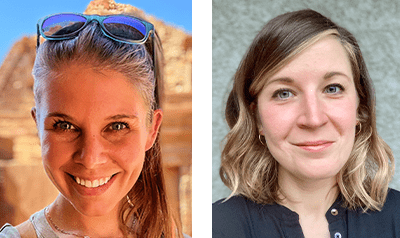Posted By: Kylee L. Spencer, PhD, Assistant Editor, AJHG
Each month, the editors of The American Journal of Human Genetics interview an author of a recently published paper. This month we check in with Elizabeth and Kendra to discuss their recent paper “Charting a landmark-driven path forward for population genetics and ancient DNA research in Africa.”

KLS: What motivated you to start working on this project?
EAS: Over the past 14 years conducting research in Africa, I’ve heard the same frustrations from African colleagues about insufficient funding for research, a lack of lab resources and infrastructure, and limited opportunities for advanced training. The DNAirobi workshop grew out of conversations among collaborators and the desire to create space for us to identify challenges inherent to doing research in Africa and that are especially burdensome to our Africa-based colleagues and discuss possible remedies. We felt such momentum after meeting that the paper came together relatively quickly over the next few months. We hope that by sharing our conversations we can reach others working in Africa and other parts of the world, and advance broader discussions about equity and inclusion in science.
KLS: What about this paper/project most excites you?
KAS: What excites me most is that this paper is the product of such a truly collaborative effort. The conversations we had at DNAirobi involved an incredibly diverse and dynamic group of people who have now also contributed their voices to this paper. It was important to us all that the discussions we had during the workshop didn’t end in that room, and it was equally important that we shared the key messages from our discussions with colleagues who did not attend the workshop. This paper represents the continued discussion of the most important topics raised at DNAirobi and an expansion of that discussion to a wider audience. The words that you read in this paper were contributed by every single one of the co-authors, and it was an honor to write this paper with colleagues who brought such different perspectives to the table and articulated their unique perspectives in such powerful and poignant ways.
KLS: Thinking about the bigger picture, what implications do you see from this work for the larger human genetics community?
EAS: We hope readers truly appreciate that major structural change will require sustained, collective effort. There are no quick fixes for the issues we raise and continuing to work in disconnected ways will not bring about the equitable research ecosystem we envision. Scholars involved in genetics and adjacent fields must begin pulling in the same direction, which is what inspired us to identify common landmarks. We also need to loudly call for top-down changes to how research is funded and rewarded in ways that build capacity and infrastructure for African scholars to lead genomics research. Without meaningful investment in African science and African scientists, our goals of an equitable and inclusive future for genomics will remain out of reach.
KLS: What advice do you have for trainees/young scientists?
KAS: Be open to new experiences that may lead you down a different path than you initially expected. I was very reluctant to work in an ancient DNA lab when I was in grad school because genetics was so unfamiliar to me; however, saying “yes” to this opportunity led me to my dream job. Don’t be afraid to pursue opportunities that are slightly outside of your wheelhouse — they may lead you to places you hadn’t imagined. And it’s never too late to redefine your wheelhouse, anyway. Look to carve out your own niche in your area of research — put in the work to become the best at whatever it is that you are most passionate about doing.
KLS: And for fun, tell us something about your life outside of the lab.
KAS: I became a mom to an amazing baby boy two weeks before our paper was submitted! I spent a lot of time while writing this paper thinking about how I want him to be proud of my efforts to create more inclusive and equitable research partnerships with colleagues from around the world. I want the research ecosystem to look very different when he is an adult. We applied for his passport when he was 5 weeks old. I am so excited to show him the world, particularly the places where I’ve worked in Africa. I have many colleagues who can’t wait to meet him.
EAS: As an archaeologist, I spend far more time in the field than the lab! I’m currently conducting research at the National Museums of Kenya where DNAirobi was held, surrounded by friends and coauthors who continue to inspire me to fight for change. It’s the human connections built through research – with colleagues, collaborators, and communities – that makes it worthwhile for me. I like that at the end of the day, we’re a particularly curious species trying to understand ourselves and our place in the world, and sharing what we learn along the way.
